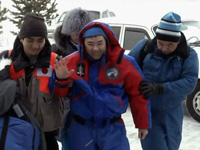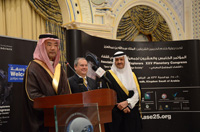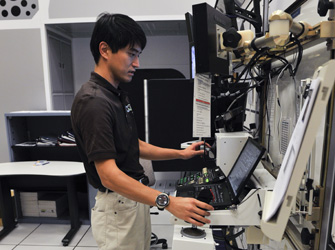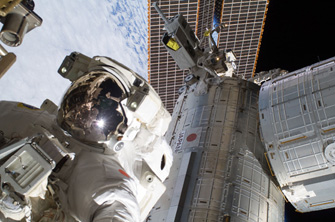JAXA Astronaut Activity Report, November, 2012
Last Updated: January 25, 2013
This is JAXA's Japanese astronaut primary activity report for November, 2012.
Astronaut Hoshide returned to Earth, successfully accomplishing his ISS long-duration mission

Hoshide smiling right after the landing (Credit: JAXA/NASA/GCTC/Andrey Shelepin)

Hoshide (center) walks accompanied by Furukawa (right) (Credit: JAXA/NASA)
On November 19, astronaut Hoshide returned to Earth, accomplishing his four-month ISS long-duration expedition 32/33 mission aboard the International Space Station (ISS).
Hoshide performed a wide range of experiments on board the Pressurized Module (PM) of the Japanese Experiment Module "Kibo," which he installed on the ISS during the STS-124 mission in 2008, as well as supporting the scientific experiments of international partners, and collecting his own medical data for medical experiments.
In addition to these experiments, he collaborated with other crew members to maintain and control necessary ISS operations. During Extravehicular Activity (EVA), he engaged in the treatment of failed critical hardware necessary for ISS operations; although some procedures did not go as planned, Hoshide and the ground team worked as a unit to accomplish the mission. Further, Hoshide spent busy days engaged in processing the frequent arrivals and departures of various supply spacecraft.

Hoshide holds a press conference after the landing (Credit: JAXA)
Hoshide and his crewmates Sunita Williams and Yuri Malenchenko left the ISS at 7:26 a.m. on November 19 (JST), aboard the Soyuz Spacecraft and landed on a snowfield in the Republic of Kazakhstan at 10:56 a.m., November 19. Prior to Hoshide's landing, astronaut Furukawa had flown to the landing site to support Hoshide. Furukawa accompanied Hoshide from the landing site to Houston, U.S.
On November 29, Hoshide held his first press conference after landing on Earth. Hoshide stated his impressions, reviewing his long-duration mission, thanked all involved for the support received, answered each question from the press courteously, such as impressions about going back to Kibo's PM and the current post-landing rehabilitation status.
Hoshide is currently undergoing rehabilitation while undergoing debriefing of the long-duration mission with related parties. In the near future, Hoshide will visit Russia and Japan for further debriefing of his mission.
Astronaut Onishi completes his robotics specialist training
Following on from the previous month, astronaut Onishi received training to become a Mobile Servicing System (MSS) specialist at the NASA Johnson Space Center in Houston, U.S.
For the last half of training this month, his focus was on capturing a spacecraft with the Space Station Remote Manipulator System (SSRMS).
For the simulation training, the Japanese H-II Transfer Vehicle KOUNOTORI (HTV) was used for a target, which occasionally included the system failure responses. As well as the role of operator, the adjacent supporter's role was repeatedly rehearsed.
When operating an SSRMS, slow and deliberate operations are key to avoid SSRMS jolts. However, balancing courage and care is also important when capturing the KOUNOTORI, as limited time is available for the approach.

Onishi's training in Canada (Credit: JAXA/CSA)
Using the simulator, Onishi acquired SSRMS operation techniques, repeatedly practicing capturing KOUNOTORI from a distance of 2 meters and finally completing the specialist SSRMS training.
Astronaut Noguchi participates in the 25th Planetary Congress of the Association of Space Explorers
From November 4-10, 2012, astronaut Noguchi attended the 25th Planetary Congress of the Association of Space Explorers in Riyadh, Saudi Arabia, which was hosted by the Association of Space Explorers (ASE).
The ASE is an organization consisting of astronauts and cosmonauts from many countries, which holds a Planetary Congress almost every year. ASE works not only to contribute to space development and human space activity, but also to promote science and technology education, and raise awareness of environmental problems.

Noguchi gives an inaugural speech as the President of ASE-Asia (Credit: JAXA)
This year's ASE Planetary Congress, the 25th, was organized under the theme "Space Technology for a Knowledge-Based Society." As part of the technical session on November 6, Noguchi presented a lecture entitled "Space Operations Today," reviewing the progress of human space flight since Yuri Gagarin's first human flight into space during the era of the former Soviet Union to the lunar landing of the Apollo program, humankind's long-term stay in space and the current ISS program.
Noguchi has been one of the ASE Executive Committee members, and during this Congress, was appointed as President of ASE-Asia. Noguchi will adopt the role of strengthening international cooperation and promoting exchanges among ASE participating countries in Asia.
Astronaut Noguchi gives a presentation at the 56th Symposium on Space Science and Technology
Astronaut Noguchi gave presentations at the 56th Symposium on Space Science and Technology, which was hosted by the Japan Society for Aeronautical and Space Sciences and held from November 20-22, in Beppu, Oita Prefecture.
Noguchi gave the special lecture on day 1, November 20, as well as a technical lecture concerning the integration of automatic spacecraft operations and control by the crew.
In addition to Noguchi's lectures, presentations on Kibo and KOUNOTORI by JAXA employees were also delivered at the symposium.
Astronaut Mukai participates in Kibo's Symposium of the Space Station Utilization Outcomes

Mukai speaks at the symposium (Credit: JAXA)
On November 5, astronaut Mukai participated in the fourth Symposium of the Space Station Utilization Outcomes held in Akihabara entitled "Space medicine contributes to life in space and on Earth." Mukai has been engaged in space medical research over the years and currently serves as director of the JAXA Center for Applied Space Medicine and Human Research (J-CASMHR).
Mukai presented a lecture in part 1 of the symposium. First, she explained the characteristics of the space environment and the differences between space and Earth, before going on to introduce research subjects such as amyotrophy and bone loss. Such symptoms resemble those of aging, and Mukai discussed how although space medicine is, strictly speaking, intended for those who go to space, it could also contribute to the aging society, and research results could help life on the ground. She also introduced JAXA's other medical research utilizing the ISS and efforts to return the product of achievements to society. At the end of the lecture, Mukai discussed the meaning of the research, emphasizing that space medicine is the ultimate form of preventive medicine and working to help life, both in space and on the ground.
In part 2, Mukai participated as a panelist in the panel discussion. The discussion proceeded such that Mukai introduced space medicine, including osteoporosis and radiation control, by responding to audience questions. The discussion included Japanese space food that JAXA collaboratively develops with private food manufacturers. According to the panelists, since Japanese food tends to include considerable salt, low-sodium food is now being studied, amid concern over the effect on bones*.
*High salt intake increases acidity in the body, which can accelerate bone loss. (see: Add Salt? Astronauts' Bones Say Please Don't)
New Astronauts at the Front-Line

Thank you for reading our diaries every month. We appreciate your continued reading our column which we all intensively write whenever we have time between trainings.
I would like to confess that I spent the whole November in language learning and physical training. The abilities acquired through these trainings are prerequisite for astronauts who undergo further training and work. Therefore, I spent as much time as possible in linguistic and physical trainings to improve my abilities even a little before the full-scale training for 2015 spaceflight starts.
At the same time, I note that these two types of abilities are part of those that becomes difficult to develop with age. It also means more efforts are demanded for me who are older than the other two new astronauts.
Dear everyone in the same generation as me, or older than I am! Do you really understand that you are getting older?
Certainly, no one can stop aging and being weakened. When feeling difficulty at the situation in front of me, I often talk to myself as follows:"It is the first important step for solution to accept this uncomfortable reality", or "What I do not want to think about now is actually what I must cogitate about at this very moment! Let's find a way for this problem now, not dealing with it later."
Honestly, I have spent quite a lot of time in linguistic and physical trainings, which is my measures taken based on the reality I face that my physical strength and memory are declining with age.
In addition, what I have to remember is that the older I get, with more care many people treat me. I believe that I have to avoid excessive care which is unbeneficial to me though some care shows politeness and works as a lubricant. If people around me become too attentive toward me and do not give me necessary information or opinion which seems unpleasant, it will deprive me of opportunities to notice uncomfortable reality far from looking into it. It will surely bring me further worsened situation without countermeasure.
Looking back at the human history, quite a many nations, organizations, and individuals collapsed making this mistake. As I talked in Twitter, this is why I am keen on collecting information and news unpleasant for me. Hence, I do appreciate your frank comments or opinions for my diary, Twitter, about space development, or everything. Your severe words for true encouragement are always welcome! I look forward to your kind support and cooperation, thank you so much!

Not having pictures of my actual training, I managed to prepare a picture of my training at home. (LOL) I have continued finger push-ups since I heard they develop one's grip. Every day I do my best to overcome my weak points with devise. (Please mind that abrupt practice without preparation may give you injuries!)
* Photo is courtesy of JAXA.

Following October column, this month, I would like to continue to introduce the robotic arm of the International Space Station (ISS) (Space Station Remote Manipulator System: SSRMS). Regarding the nature of the robotic arm, please check my column of last month. This month, I will briefly describe the trainings which astronauts undergo.
Firstly, let me explain about manipulation of the arm with two controllers: manipulate the arm with one controller gripped in left hand, the other in right hand.

This photo shows my manipulation of the SSRMS simulator, in which the one with my left hand is the controller moving the robotic arm back and forth, left and right, and up and down in three dimensional space. (Actually, the universe does not have vertical conception and requires manipulator's definition of coordinate system. Its complicated explanation is omitted here.)
The other controller, often seen in the simulator system of airplane, manipulates the attitude of the arm. Manipulation of this controller changes the direction in which the arm faces.
Simultaneous manipulation of these two controllers enables three dimensional movement of the arm to the desired point and direction at one time. Controlling different two functions at the same time with two hands is really tough and shows the skills of astronauts.
Of course, no one is good at such complicated manipulation without preparation, which means that the training is essential even for astronauts as well. This is just like training at a driving school before driving a car on public roads. At first, we learn how to start and stop, then go straight, make a turn...
The manipulation training of the robotic arm is very similar to the driving practice. Astronauts practice with smooth manipulation of the controller slow movements, stop, and simple straightforward movements of the arm, additionally oblique movements when they become familiar and good at manipulation.
Following basic training for acquiring the arm manipulation skills, practical training awaits us. Though you may be surprised, as a matter of fact, we astronauts do not have so many opportunities to actually manipulate the robotic arm onboard the ISS. This is because in most cases the arm can be remotely operated from the ground. There are only two cases which cannot be managed with on-ground control and require astronauts' actual manipulation in space: One is supporting Extravehicular Activity (EVA), the other is capturing spacecrafts approaching the ISS.
These two cases require prompt and timely manipulation in space which cannot be remotely operated from the ground. That is why astronauts have severe training for the cases. The situation in space sometimes gives them no choice but to cope with system damage by themselves as well as the arm manipulation.
Now, I would like to report my training for capturing H-II transfer vehicle KOUNOTORI with the robotic arm just like on-the-spot broadcasting. I hope you can enjoy the atmosphere of the actual training.
The training is reported by Narrator, the Robot Arm Manipulator (me, referred to as I below), and Instructor (supporting astronaut)
.....
I "Now I will start capture of KOUNOTORI. Manipulation started."
Narrator "Now Onishi Astronaut starts carefully moving the robotic arm. He has to avoid rapid movements which may cause vibration of the whole arm."
Instructor "Copy that. Your manipulation is identified. Now you are located at about five meters from KOUNOTORI, gradually getting far from it."
I "I will increase proximity a little to KOUNOTORI."
Narrator "Onishi Astronaut is adjusting the arm's relative velocity to KONOTORI which is getting far away from the ISS. At the same time, he also has to operate the arm coordinating the vertical and horizontal gap between the arm and the transfer vehicle. He's busy!"
Instructor "Proximity is improving. You are approaching at 4.5 meters from the transfer."
I "I will increase the proximity a little more."
Narrator "Proximity is certainly improving. Though vertically and horizontally a little off the target, it keeps moving. Is this because he may consider this is enough when the arm is still distant from KOUNOTORI?"
Instructor "Approaching. Distance less than 2.5 meters."
I "Copy that. I will transmit Free Drift instruction to KOUNOTORI."
Instructor "Copy that. Free Drift is transmitted. KOUNOTORI identified the mode change to Free Drift."
Narrator "Yes, he completed the mode change to Free Drift. From now KOUNOTORI will control its attitude without a jet of thruster. It must be captured immediately."
I "Completed mode change is understood. Proximity is maintained. I am now modifying the gap in the right."
Instructor "Copy that Distance 1.5m ... 1m"
Narrator "Approaching requires slight minute modification. Astronaut Onishi should coordinate according to the movement of KOUNOTORI, floating in space only by inertia."
Instructor "... distance 60cm ...30cm"
I "The gap between KOUNOTORI and the arm is all within acceptable range. I will continue the capture."
Instructor "Acceptable range is understood. Agree to your continuing the capture."
Narrator "It is the critical point when astronaut identifies the relative gap between the arm and KOUNOTORI is within a certain range! Astronaut and supporting Astronaut mutually confirms the gap. Now they are close."
Instructor "KOUNOTORI enters the possible range for capture."
I "I will start the arm's capturing KOUNOTORI!"
Instructor "Copy that!"
I "......!?"
Narrator "Oh-oh, accident arises! Instructor seems to have entered damage in simulator. The robotic arm does not start capturing. What is Onishi Astronaut going to do??"
I "I identified a problem arises. According to the procedure, I will refer to the problem reckoner. I judge this case as Case 2, the one which does not allow completion of the capture."
Instructor "Agree."
I "According to the reckoner instruction, I will implement the change to the backup system."
Instructor "Copy that."
Narrator "Onishi Astronaut remains unruffled, steadily handling with a problem according to the procedure. His previous work experience as a pilot serves him. Now he seems to have completed the change to the backup system."
I "I will start capturing again."
Instructor "Starting capture is identified. ...Pins are drawn, identified.... ...Tension is good. Capture of KOUNOTORI is identified!"
Narrator "He successfully completes the capture using the backup system! Onishi Astronaut shows a relieved face. But, dear he, debriefing of the inspector awaits him. Despite the successful capturing, we hope he examine points to review, for example about his operation until the capture, validity of his judgment, etc., and make the best use of them. Now the time is coming to say goodbye. How do you find my on-the-spot broadcasting of a training of an astronaut? See you another time then..."
* Credit: JAXA/CSA

Hello, everyone. I am Norishige Kanai, a JAXA astronaut and "moguri" (this is a Japanese word with double meanings of diving and under-surface, unlicensed) doctor. ...Of course, I do not mean my doctor license expired or something like that.
Before entering JAXA, I was in charge of health care management of divers at the Maritime Self Defense Forces. In other words, I was a 'moguri' (meaning diving and unlicensed) doctor, which is a joke often used in the business. I am sorry if my boring pun makes you become strained.
Environmental medicine, particularly, submarine medicine is a specific medical field studied as one of the minor fields. This medicine deals with prevention and treatment of diving-oriented various health disorders.
After studying diving medicine in addition to their own specialty such as surgery, internal medicine, or otolaryngology, a half of medical officers working for the Maritime Self Defense Forces acquire a license as a diving medical officer. (The other half of them undergoes the training for a flight surgeon with medical officers of the Air Self-Defense Force.)
Diving medical officers, who have training to dive into the sea to experience varied types of diving apparatus, mainly take an active part on the deck of a diving boat and medical facilities including hospitals and medical offices. They dive even out of water (in a high-pressure chamber) as well as beneath the sea, operating Hyperbaric oxygen therapy (HBOT) equipment installed for the bends treatment, being actually pressurized accompanying patients who requires treatment.
It is not only the Maritime Self Defense Forces that work with diving apparatus in the water. Private business operators also handle underwater work such as salvage, exploitation, and construction, while leisure dive is so popular that many people enjoy its underwater activities.
Diving, a safe sport which everyone in good health can enjoy, also has natural risk because humans originally cannot stay long under water without diving apparatus.
As you with diving license know well about, diving, which may cause sickness called the bends depending on the way it is conducted, have laid down detailed rules about possible time length and depth to stay under water, required rest time between the dives, and so on.
Whether private or Self-Defense Forces, doctors and people in health occupation are concerned with daily medical care while studying the bends day after day, its causes, prevention, and the best treatment in case someone get.
Well, as written in the title, surprisingly, the bends may occur also in space. There are many possible causes, one of which is Extravehicular Activity (EVA) which I introduced in my column last month.
To begin with, what causes the bends? Let's imagine that we are diving with scuba diving apparatus on the ocean floor, for example.
Pressure (hydraulic pressure) increases under water than on the ground, which means the air used when breathing with diving apparatus is also pressured more than on earth. It might be hard to grasp the image: the amount of the air included in one-time breathing under water is the same as that on the ground in volume, while, actually, the amount of included molecular oxygen increases dependent on the number of ambient pressure. In the ocean floor at a depth of 10 meters, our bodies experience two atmospheres with our breathing air including double amount of oxygen and nitrogen on the ground.
The longer we enjoy on the sea bottom, watching and taking pictures of beautiful fish, the more nitrogen in our pressurized air used in breathing gradually dissolves into our bodies.
Going up to the sea surface in this state (or the state of one atmosphere), the nitrogen which dissolved into our bodies is slowly discharged through our lungs along with decrease of the pressure on our bodies.
This smooth process though stern observation of dive rules assures no problems and no health damage. In the case of excessive amount of nitrogen in human body caused by too long underwater stay, or insufficient nitrogen discharge time due to too quick ascent, however, human body cannot properly cope with the dissolved nitrogen which cannot remain internal and form gas bubbles in body (particularly in veins). The bubbles result in various health disorders by blocking blood flow. This is the bends.
Theoretically, the similar phenomena may occur in a spacecraft. Let's take an example of extravehicular activity (EVA). On the International Space Station (ISS), the pressure is controlled to one atmosphere, the same as on Earth. After changing into space suits, astronauts go outside of the ISS, where it is vacuum (zero atmosphere). Beforehand, astronauts in space suits on the ISS enter a special room called Airlock where they adjust the ambient pressure to space removing the air, then open the hatch to go into space.
As written in my column last month, inside space suit is filled with oxygen of about 0.3-0.4 atmosphere. If the atmosphere is lower than that, oxygen density becomes too low and astronauts feel hard to conduct physical activities, while too high atmosphere expands space suits in which astronauts cannot move.
That is why astronauts in spacesuits decrease the pressure in their suits from one to 0.3-0.4 atmosphere. This process is exactly the same as divers who absorb the pressurized air under water ascend to the surface at one atmosphere.
To avoid astronauts who is going out of the ISS for EVA right now getting the bends, varied prevention measures are taken with the best use of submarine medical knowledge: one of them is called campout. Astronauts acclimate themselves to the environment with decreased pressure by spending one night in Airlock where inner pressure is kept lowered. Or another method is forced discharge of nitrogen through physical exercise with exercise bike using oxygen mask for a certain time. Recently shorter safe acclimation method combining oxygen inhalation with light exercise is being developed.
For medical support of astronauts, doctors specializing in space medicine and called Flight Surgeons and sanitarians called Biomedical Engineers (BME) stand by in a 24-hour system at the ground control center. Their instructions help astronauts in space decompress safely and effectively.
Undoubtedly, even during EVA, the control room always monitor the electrocardiograms of astronauts, data of their spacesuits, and their conversation, which provide astronauts full health management support in the utmost secure system
Even in such an extreme system, what if astronauts should get the bends in space?
On the ground, when a person gets the bends, he will have hyperbaric oxygen therapy in a special facility. Instead that they does not have a therapy facility on the ISS, astronauts treat the patient by putting in a spacesuit and pressurizing with oxygen. This enables medical care of the bends though the high pressurized space suit cannot be reused. It is amazing that our spacesuits are so well designed that they can serve as medical care equipment for the bends.
Additionally, astronauts have special support of fight surgeons and EVA experts when they conduct dangerous activities such as EVA, which has fortunately contributed to no reports of the bends occurrence relating to EVA to date. Please feel relieved!

Hoshide Astronauts conducting EVA
Every data relating to EVA actually conducted on the ISS, the one implemented by Hoshide Astronaut who has returned to Earth recently, for example, is recorded and will serve as source material for development of more safe and effective activity methods
I think that utilizing accumulation of such data also for on-earth activities may contribute to more safe and effective dive and EVA.
* Credit: JAXA/NASA












